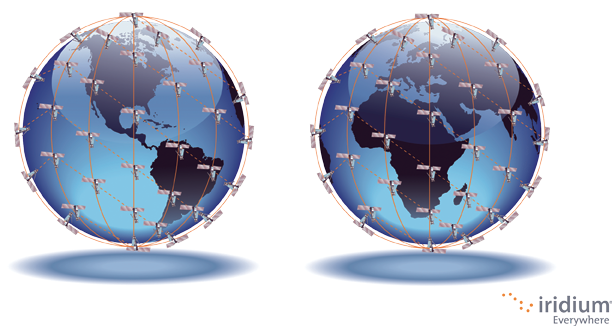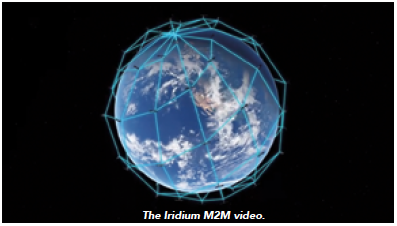The industry is predicting monumental growth for satellite-enabled M2M over the next 10 years. In the near term, 2015 will be a pivotal year in the evolution of satellite’s role in M2M.

One of several key factors shaping trends in satellite-enabled M2M includes the rise of Original Equipment Manufacturer (OEM) customers as a driver for satellite connectivity for asset tracking and telemetry applications. The fleet management market’s desire to integrate satellite into existing cellular-enabled telematics solutions is another driver of growth. What’s more, developments in 2014 have charted a path to lower the barrier to easily add satellite connectivity in 2015, enabling higher value M2M applications, and global coverage.
In the longer term, upcoming next-generation satellite networks will offer increased bandwidth, while evolving satellite M2M services to resemble cellular IP-based services. Satellite provides the ultimate wide area network (WAN), covering the more than 80 percent of the Earth’s surface not covered by cellular.
What are some of the industries and applications that satellite M2M is powering? Here are just a few of the many M2M use examples:
• In the Oil and Gas industry, satellite-connected sensors on oil and gas wells transmit information about production rates and operational parameters.

• Fleets of trucks that move assets around the world use satellite-connected transceivers to connect to solutions that verbally coach drivers on improving efficiency in remote areas as well as providing security monitoring for the cargo. The produce that is in your local grocery store may have had its temperature monitored for freshness via satellite on part of its journey from the farm to the store.
• Workers in the logging industry use satellite-connected two-way devices for personal communication and safety, like transmitting SOS alerts.
• Heavy equipment, such as Earth-moving bulldozers, use satellite connectivity to monitor and transmit vehicle diagnostics in remote areas beyond the reach of cellular.
As emerging markets continue to seed demand for infrastructure building and other industrial development, OEMs need ubiquitous and reliable connectivity to support their products and services—not just the large OEMs, but also the smaller ones are realizing the potential of M2M by integrating satellite connectivity options. Applications range from tracking where something is located to more advanced telemetry and diagnostics to monitor the performance and condition of equipment.
The need for this type of intelligent data doesn’t end at the boundaries of cellular coverage. Satellite connectivity plays an important role in enabling businesses to manage their operations more efficiently, wherever they are on the Earth. Satellite enables the customer to derive the full benefits of M2M even when a cellular connection is not available.
Fleet management solutions depend on reliable two-way communications for logistics. Moreover, the logistics are in a context of ever-changing business needs: The particulars of a transport might change between a truck leaving its depot in an area with cellular coverage and arriving at its destination outside of cellular coverage. Therefore, constant connectivity is imperative for enabling maximum return on investment. Many telematics providers already offer solutions that have cellular connectivity, and they want to be able to add satellite connectivity to their existing solutions rather than building a new solution from the ground-up.
As satellite transceivers have become smaller and more affordable in 2014, the barriers to entry for existing cellular telematics providers to quickly add satellite connectivity are now much lower. Antenna manufacturers such as Hirschmann and Taoglas have integrated satellite transceivers directly into their antenna packaging, enabling satellite M2M connectivity to be easily and cost-effectively added to an existing cellular solution in a small form factor. This approach, although incremental, represents an important shift in how companies can extend the capability of their fleet management solutions, and extend connectivity to their customers around the world.
Satellite is a key part of delivering the full investment of M2M. There is no one perfect technology or wireless network—M2M requires the integration of multiple wireless networks. While satellite doesn’t drive the more diverse M2M applications, it drives much higher-value applications.
The diverse range of capabilities from low-cost asset tracking to advanced telematics, such as condition-based monitoring, demonstrates satellite M2M’s vast possibilities. Satellite data connectivity is no longer confined to the realm of phones and large terminals. Today’s satellite communications providers have extended their connectivity beyond the large terminals that are familiar to many in the industry.
Satellite connectivity has been scaled down to small modules, chips and antennas that fit in the palm of one’s hand, enabling a larger scale of flexibility for satellite-connected solutions that were not previously possible. Moreover, satellite networks that are reliable and have low latency are well-suited for M2M applications.
In the next few years, next-generation satellite constellations that offer larger bandwidth and higher data speeds will foster richer satellite M2M connectivity services that more closely resemble cellular IP-based services. In truth, most end users do not care how a provider sends the data as long as they get what they expect, when they expect it, and at the agreed cost. Perhaps most importantly, satellite connectivity will be easier to integrate, which means that solutions providers and end users alike will have a larger realm of possibilities for their M2M applications. For those satellite networks that already have truly global coverage, this advantage will continue even as new constellations launch—providing M2M applications in areas that are underestimated and underserved hotbeds of industrial activity—like maritime shipping routes in the Arctic circle.
As the satellite industry and its technologies continue to involve, so will the possibilities for the Internet of Things (IoT)—connected vehicles, assets, and more—across the Earth.

For additional information:
The Iridium M2M infosite is located at https://www.iridium.com/about/IndustryLeadership/M2M.aspx
David Wigglesworth is the Vice President of Data Services at Iridium Communications Inc.. He is responsible for business development and strategy for M2M markets. Mr. Wigglesworth holds Masters Degrees in Communications Engineering and Business Administration.


